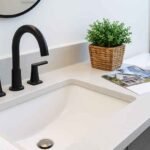 Home improvement projects often focus on style — new tiles, sleek fixtures, modern lighting. But behind those updates lies a crucial part of your home that rarely gets attention: the plumbing system.
Home improvement projects often focus on style — new tiles, sleek fixtures, modern lighting. But behind those updates lies a crucial part of your home that rarely gets attention: the plumbing system.
Plumbing upgrades aren’t just about convenience. The right improvements can help prevent leaks, reduce water waste, and even extend the lifespan of your home’s infrastructure. If you’re planning a renovation or simply want to avoid costly plumbing emergencies, here are the most effective upgrades to consider.
1. Install a Whole-Home Water Filtration System
Minerals, chlorine, and other contaminants in tap water can corrode pipes and fixtures over time. A whole home water filtration system not only improves water quality but also protects your plumbing from buildup and damage.
Why it matters:
Cleaner water means less scale inside your pipes, smoother appliance performance, and fewer plumbing issues in the long run.
2. Add Water Leak Detection Devices
Smart leak detectors can sense even the smallest leaks — sometimes before you notice any visible signs. These devices alert you via smartphone or automatically shut off the main water valve when a leak is detected.
Why it matters:
Early detection can save thousands of dollars in water damage repair costs and prevent mold growth.
3. Upgrade to a Pressure-Regulating Valve
High water pressure might feel great in the shower, but it puts unnecessary stress on your pipes, joints, and appliances. A pressure-reducing valve (PRV) keeps your home’s water pressure at a safe, consistent level.
Why it matters:
Regulated pressure extends the life of your plumbing system and minimizes the risk of burst pipes or fixture leaks.
4. Switch to a Tankless Water Heater
Tankless water heaters provide hot water on demand without storing gallons of it in a tank. They’re energy-efficient, space-saving, and can last nearly twice as long as traditional models.
Why it matters:
You’ll reduce both your energy bills and the chance of tank corrosion or leaks — one of the most common plumbing problems in older systems.
5. Install Smart Water Monitoring Systems
Modern smart home technology can track water usage in real time and alert you to unusual patterns — such as leaks, running toilets, or a dripping faucet.
Why it matters:
Monitoring helps you conserve water, spot inefficiencies, and take corrective action before issues escalate.
6. Replace Old Piping Materials
If your home was built decades ago, it might still have outdated pipes like galvanized steel or polybutylene — materials prone to corrosion and bursting.
Why it matters:
Repiping with copper or PEX (cross-linked polyethylene) improves flow, durability, and overall water safety.
7. Upgrade Fixtures and Faucets
Newer plumbing fixtures are designed to be both stylish and efficient. Water-saving faucets, showerheads, and toilets can drastically reduce water use without compromising performance.
Why it matters:
You lower utility costs while helping the environment — a win-win for both your home and your wallet.
8. Add a Water Softener System (If You Have Hard Water)
Hard water is one of the leading causes of mineral buildup inside pipes and water heaters. Installing a water softener system can eliminate these minerals and extend the life of your plumbing.
Why it matters:
You’ll notice fewer clogs, cleaner dishes, softer laundry, and longer-lasting appliances.
9. Schedule a Professional Plumbing Inspection
Even with all the best upgrades, regular maintenance is key. A licensed plumber can check for hidden leaks, inspect joints and seals, and ensure everything’s running efficiently.
Why it matters:
Routine inspections help you catch small problems before they turn into expensive repairs.
The Takeaway
While kitchen remodels and new paint often steal the spotlight, plumbing upgrades are what protect your investment long-term. By integrating a few smart systems and preventive measures, homeowners can avoid the stress, expense, and mess of sudden plumbing failures.
Think of it as improving not just how your home looks — but how well it lives.





Leave a Reply